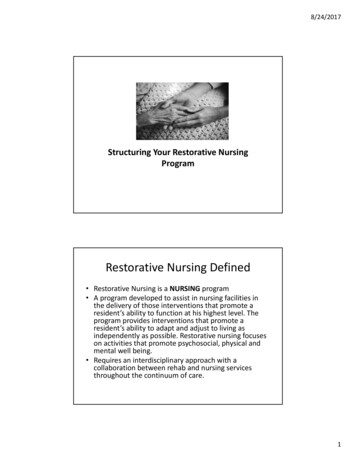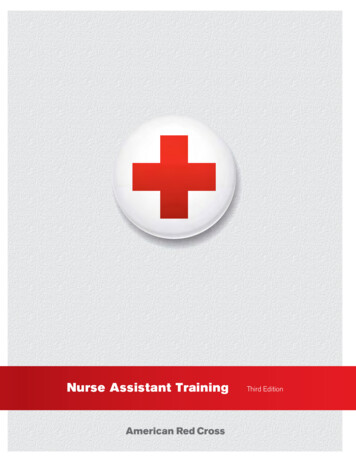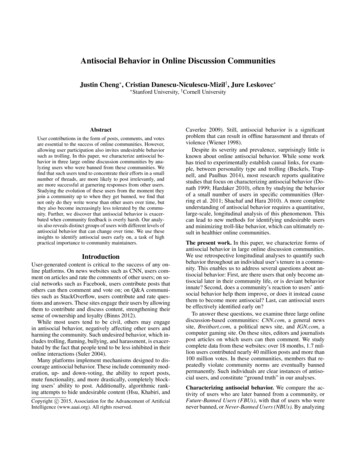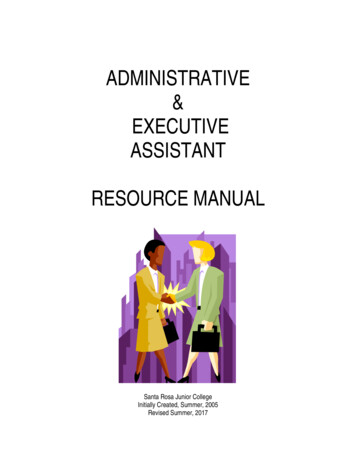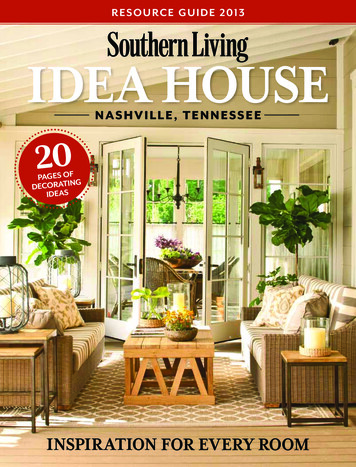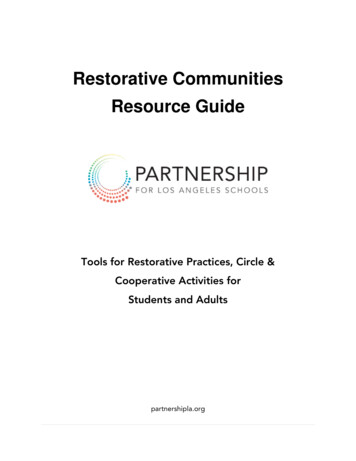
Transcription
Restorative CommunitiesResource GuideTools for Restorative Practices, Circle &Cooperative Activities forStudents and Adultspartnershipla.org
2 Page
Table of ContentsAbout This Book and the Partnership . . .Page 5Introduction to Restorative Communities .Page 6Circle Format and Rubric . .Page 8135 Community Building Circle Questions .Page 13Restorative Communities Lead, Culture Teams, Culture Goals . Page 14Working with Families . Page 154 Social Emotional Competencies . Page 16Tier 1 Circle Template . Page 17Sample Circle Lesson Plans .Page 18Affective Statements & Questions . .Page 21Feelings Inventory . .Page 22Needs Inventory . Page 24Motivational Interviewing . Page 25Non-Violent Communication . .Page 27Tier 2 & 3 Circle Format . .Page 28Intake Form . .Page 29Restorative Reflection & Agreement . .Page 30Student Agreement & Support Plan . . .Page 31RC TLF Elements . . Page 32School-wide RJ Campaigns .Page 39Trauma-informed Practices Page 40Mindfulness & Meditations . . .Page 41Selected Restorative Communities Related Quotes . .Page 42Suggested RJ Resources . .Page 44Living Restoratively .Page 45Community Building Activities .Page 46Circle Agreements .Page 813 Page
Ball TossPage 46 NumbersPage 61BlizzardPage 47 Opposites ChantPage 62Big Wind BlowsPage 48 Our Hands Are For Or We Bring and We LeavePage 63Car and DriverPage 49 Pass a ClapPage 64Cooperative Musical ChairsPage 49 Pass the Squeeze/PulsePage 65Cross the LinePage 50Page 66Cup and StringPage 51 RainstormPage 67Draw What I DrawPage 52 Silent Line-UpPage 68Embodied/Somatic MemoriesPage 53 Silent SwitchPage 69E.T.Page 53Page 70Group JugglePage 54 Social Emotional Word WallPage 71Ha Ha GamePage 55 Today I BringPage 72Hula Hoop ActivityPage 56 The Toilet Paper activityPage 73Human KnotPage 57 Toxic Swamp CrossingPage 74I Am PoemPage 57 Tug of PeacePage 75Impulse ChickenPage 58 Values SharingPage 76Kitty Wanna Corner, Ask My NeighborPage 59 Veggie StewPage 77Mailboxes and Notes of AffirmationPage 59 Wall of LovePage 78Mama Bird, Baby BirdPage 60 Web of ConnectionsPage 79Mystery ClapPage 60Page 79Name TentPage 61 Zip, Zap, ZopPeople to PeopleShark AttackZoom, Zoom, SkirtPage 804 Page
About This BookThis resource guide is designed for educators to reference to facilitate dialogue and activitiesthat support cultivating healthy, restorative communities.About the PartnershipThe Partnership for Los Angeles Schools in a non-profit organization created in 2007 to transformhistorically under-served schools and serve as a scalable transformation model for Los AngelesUnified School District (LAUSD), the State of California, and the nation. The Partnershipdramatically accelerates achievement for students in the district’s highest-need schools byoperating a network of 18 schools (14,000 students) in Boyle Heights, South LA, and Watts. ThePartnership is one of the largest public school turnaround initiatives in the nation. Over their firstseven years, Partnership schools have more than doubled their four-year graduation rate from36% to 77%. Furthermore, in the first year of the new Common-Core aligned Smarter Balancedexams, the Partnership closed the proficiency gap to LAUSD by 4% points in English and 9%points in math. To learn more about the Partnership, please visit our websiteat www.PartnershipLA.org.5 Page
What are Restorative Communities?Restorative communities are safe spaces (physically, intellectually andemotionally), composed of respectful and responsible adults andstudents. Restorative communities promote a positive and healthyschool culture by building, strengthening and (when harm occurs)repairing relationships through social-emotional learning, circlepractice, and restorative dialogue.What is Restorative Justice (or Discipline) in Schools?Rooted in the restorative justice model of some international criminal and juvenile justicesystems, restorative justice in schools is an approach to heal harm. In schools, restorative“justice” can also be understood as restorative “discipline,” the intervention tiers of restorativepractices.Traditional Discipline Who broke the rule?What rule was broken?What punishment does theoffender deserve?The person harmed (victim) isnot involvedRules, fault and punishment arekeyRestorative Discipline Who was involved and how?Which relationships have been harmed?What do participants (particularly thoseharmed) need?Everyone impacted has an opportunity tocreate an agreement to heal and preventfuture harmRelationships, respect and responsibilityare keyWhat are Restorative Practices?Restorative practices are a collection ofactions that aim to build, maintain, and whennecessary, repair relationships. At a universaland preventative level (Tier 1), all staff andstudents can build and maintain relationshipsthrough community building and curriculumcircles, social-emotional learning, affectivestatements, and non-violent communication.At a level of targeted intervention (Tier 2),when harm or significant challenges occur,restorative practices may include activelistening, motivational interviewing, conflictcircles, circles of support, or individualrestorative conferencing and dialogue. Forthe most severe harms (Tier 3), typically aftera student has been removed from class orschool, the highest level of support mayinclude a re-entry circle or restorativecommunity conference and on-going circlesof support to re-integrate the student intothe school community.6 Page
What is a Restorative Approach?“The fundamental hypothesis of restorative practices is that human beingsare happier, more cooperative and productive, and more likely to makepositive changes in their behavior when those in positions of authority dothings with them, rather than to them or for them.”- International Institute for Restorative PracticesWhat are the Key Terms of Restorative Communities? Affective Statements: Expressions of personal feelings, both positive and negative, describing howone is affected (e.g. “I feel when .”). Affective Questions: Questions asked to understand how people are affected (impacted) by anincident. These questions seek to understand feelings and needs. (“Who do you think has beenaffected and how?”). Active Listening: Words and body language that invites thoughtful reflections (e.g. restating,summarizing, minimal encouragers, effective silence). Restorative Dialogue/Motivational Interviewing: Collaborative conversations aimed at strengtheninga person’s own motivation and commitment to change or to attain a specific goal. Questions are openended to invite conversation to uncover and address the root causes of conflict and challengingbehavior. (Tier 1) Circle: Proactive circles where participants are invited torespond to open-ended questions related to community building,curriculum, issues, support, or celebration. The format typically includesdiscussing circle agreements, using a talking piece, and responding to acheck-in question, round questions, and a check-out question/closing. (Tier 2) Support/Issue Circle: Using the circle agreements,support/issue circles address on-going social-emotional needs forstudents experiencing similar types of trauma or challenge. (Tier 2) Harm/Conflict Circle: After preparing individuals involved(using restorative dialogue and inviting individuals to voluntarilyparticipate this circle), harm/conflict circles use the circle agreements todiscuss, understand, and repair harm. Participants draft agreements toheal the harm and the circle keeper follows up soon thereafter. (Tier 3) Re-entry Circle/Community Conferencing: For students who have been away from school orclass (either because of suspension, opportunity transfer, incarceration or other), a re-entry circle usesthe circle agreements to welcome the student back to the school/class community and share resourcesand support to avoid repeating the harm. A community conference may invite additional members ofthe community, family, and/or specialized services.7 Page
Community Building Circle FormatA Suggested Guide for Circles in the ClassroomSignal or Phrase to Identify Circle TimeStudents must know that circle is about to happen, whether it’s as soon as they walk in the room or there is a practicedprocedure for getting into circle.Physical Arrangement of CirclePhysically arrange participants in a circle, whether by sitting in chairs/desks that face inward or standing in a circle so thatall participants can view one another.1. Welcoming/ 3 R’s/OpeningWelcome participants to circle, discuss the purpose of circle (respect, relationships, responsibility), and open the circle(perhaps with a song, quote, poem, or breathing exercises).2. Introduce/Review Agreements (and Ask for Agreement to Agreements)Facilitator or participants should explain the following elements of circle (or a version agreed upon for the group). Circle Agreements Respect the Talking Piece Speak and Listen from the Heart Speak and Listen with Respect Honor Privacy Say Just Enough “Shaky” Hands (or other positive gesture to signal empathy and agreement)3. Introduction to Talking PieceExplain significance and value of talking piece.4. Check In QuestionThe Circle Keeper/Facilitator asks a question with a short response, typically about the present time. The talking piecethen typically passes person-by-person to the left (the side our heart is on). Examples:·How are you feeling in this moment? How has your day been so far?·What would be important for this group to know about you right now?5. Community Building RoundsMore open ended questions, may involve narrative and should typically build from more surface level questions to deeperquestions over time (perhaps over several circles). Examples:·What’s your favorite smell, candy, color, etc.? Who or what brings you joy?·When did you recently experience success?6. Check Out Question/ClosingReflection question about the day or the future. Examples:·How are you feeling at the end of circle practice today? What are you looking forward to?·What’s a goal you can set and accomplish for today?*Note: A circle could be as short as a Check In Question and a Check Out Question to build community and communication skills or as long as an entireclass period to discuss content and curriculum8 Page
Restorative Communities Classroom-level RubricTier 1 Restorative Circles: Community Building and Curriculum CirclesA tool for self-evaluation, observation, and educator growth and developmentCircle Component[TLF Connection]Planning & Preparation[1b1 Awareness of Students’Skills, Knowledge andLanguage Proficiency; 1b4Knowledge of Students’Interest and Cultural Heritage]Physical Space[2b4 Physical Environment; 2c1Routines & Procedures]Phase 1BeginningFacilitator has planned severalquestions and activities for thecircle.Circle Agreements[2b2 Expectations for Learningand Achievement; 2d1Expectations for Behavior]Circle agreements are postedand reviewed before beginningcircle. Participants are invitedto show a sign of agreement(e.g. deaf applause or snaps)with the circle agreements.Facilitator defines the CircleAgreements for participants.All participants are arranged ina circle, whether seated orstanding. Instructional timemay be lost while transitioning.Phase 2DevelopingFacilitator has purposefullyplanned questions andactivities for the circle, with aparticular attention toparticipants’ skills, languageabilities, and interests.All participants are arranged ina comfortably seated circle andable to view every otherperson, without obstruction.Minimal instructional time islost while transitioning.Circle agreements are postedand participants are invited toexplain their meaning prior tobeginning circle. Allparticipants are invited to showa sign of agreement with thecircle agreements. Facilitatorasks the participants todefine/describe the CircleAgreements.Phase 3AdvancingFacilitator has includedparticipant voice in planningpurposeful questions andactivities. Participants may havecreated the questions/activitiesthemselves.Participants efficiently help toarrange the physical space intoa circle, where all participantscan see one another withoutobstruction, and help returnthe physical space to rows,groups, or other seatingarrangements. Instructionaltime is maximized.Circle agreements are coconstructed with participantsand discussed prior tobeginning circle andthroughout the circle, asapplicable. All participants areinvited to show a sign ofagreement with the circleagreements. Participants sharepersonal commitments toindividual Circle Agreements.9 Page
Facilitator Responsibility[2a1 Teacher Interactions withStudents; 2d2 Monitoring andResponding to Student Behavior]Facilitator models respectfultone, word choice andinteractions. Educator modelsaffective statements and activelistening. When necessary,educator responds tomisbehavior respectfully.Participant Voice andParticipation[2a3 Classroom Climate; 3b2Discussion Techniques andStudent Participation]Some participants share theirresponses and ideas in circle.Several participants pass thetalking piece without sharing.Some students show non-verbalsigns of empathy, recognition, orappreciation (e.g. deaf applauseor snaps).Participants are generallyrespectful of one another incircle. Some participants maystruggle with demonstratingrespect and taking responsibility.Facilitator somewhat modelssocial-emotional vocabulary andprovides some opportunities forparticipants to express socialemotional language.Participant Responsibility[2a2 Student Interactions withOne Another]Social Emotional Language[3a4 Use of Academic Language;3d4 Student Self-Assessment andMonitoring of Progress]Facilitator models and invitesrespectful tone, word choice andinteractions. Educator modelsaffective statements and activelistening. Facilitator reinforcespositive behavioral choices and,when necessary, responds tomisbehavior respectfully.Facilitator models, invites andencourages respectful tone, wordchoice and interactions.Facilitator models and describesaffective statements, activelistening, and restorativedialogue when necessary.Facilitator reinforces positivebehavioral choices and, whennecessary, responds tomisbehavior respectfully andequitably.Most participants share theirMost participants freely andresponses and ideas in circle. Few comfortably share theiror no students pass withoutresponses, ideas, and questionssharing. Many participants showin circle. Most participants shownon-verbal signs of empathy,non-verbal signs of empathy,recognition, or appreciation.recognition, or appreciation.Many participants take risks andare vulnerable in circle.Participants are respectful of one Participants encourage oneanother in circle. Mostanother in circle. All participantsparticipants consistentlyconsistently demonstrate respectdemonstrate respect and takingand taking responsibility.responsibility.Facilitator often models socialFacilitator models socialemotional vocabulary andemotional vocabulary andprovides several opportunities for provides many opportunities forparticipants to express socialstudents to express socialemotional language, includingemotional language, includinggoal-setting and reflection.growth mindset, self-efficacy, selfmanagement, and socialawareness.10 P a g e
135 Community Building Questions (for Circle or Other )34)35)36)37)38)39)40)41)42)43)44)45)What is your favorite sports/food/color/smell/subject/artist/team/tv show/movie/song/etc.?What’s your favorite .?What do you like to do during your free time?What do you want to accomplish?What is one of your dreams?If you could have dinner with anyone dead or alive, who would that be and why? What wouldyou talk to him/her about?If you could have one superpower, which one would that be? If you could be a superhero, whichwould you be and why? OR If you could become your own superhero, what would your nameand costume be?Who do you admire and why?If you could take only 3 things on a desert islands, what would that be?What is one thing you are worried about or afraid of?What did you wanted to be when you were a kid?What do you plan to do after high school?How are we privileged?What brings you joy? What’s a memory that brings you joy?What do you appreciate about your work or main activity?How would your best friend describe you?What would you not want to change about your life?If you could talk to someone from your family who is no longer alive, who would it be and whatwould you tell him/ask himIf you had an unexpected free day, what would you like to do?If you were an animal, what animal would you be and why?Who or what makes you laugh? Who or what makes you smile?Who do you think is a good role model for young people?If you were prime minister or president of the world, what laws would you make?What was your last dream about?What would you do if you won the lottery?What talents do you have?What was your favorite holiday?Where would your dream vacation be?If you could go back in time and change one thing, what would it be?If you could live anywhere, where would that be?If you could go back in time to change one thing what would it be?Have you ever been admitted to hospital?What scars do you have and what’s the story behind it?Have you ever been on TV?Have you ever met any celebrities?Have you ever done something heroic?What would be your best achievement to date?Have you ever built a snowman? How did you do it?If you could live anywhere, where would that be?Would you like to be a big celebrity? If so, what would you be famous for?If your house or school was on fire, what items would you take with you?What do you typically have for breakfast?If you could change anything about yourself what would it be?Would you rather trade some intelligence for looks or looks for intelligence? Why?If you could ask your future self a question, what would it be?11 P a g e
96)What historical figure or concept would you love to see in 21st century life?If you could learn any language fluently what would it be and why?What was the last song you danced to?What was the last book you read?What would be your dream car?What was your favorite birthday?How old were you when you last went trick or treating?What do you have on your fridge door?What’s your first thought upon waking up?Do you have any superstitions?Do you have any lucky items, objects or traditions?What do you think the greatest invention has been?How long does it take you to get ready for ?Have you ever done something really unbelievable, only to have no one around to see it?Have you ever raised money for charity? If so, which? If not, would you like to and which one?If you were in a band, what instrument/role would you play?What’s your opinion on ?Do you have any unusual fears or phobias?Do you live by any motto or philosophy?Could you ever hunt, gather or grow your own meal?What do you do to cool down when it’s hot?What’s the most unusual thing you've ever eaten?Do you collect anything?Is there anything you wished would come back into fashion?If you could have any feature from an animal what would you want?What makes you nervous?Which of the 5 senses would you say is your strongest?If you and a friend both wanted the same thing would you let the friend get it first?What do you do to stay healthy?If you were ruler of your own country what would you call it?If you invented a monster what would you call it and what would it look like?If you were captain of a ship, what would you call it and where would you go?What’s the hardest thing about being your gender/age/grade?What’s the best thing about being your hat’s the best/worst thing about school/this class/our neighborhood/etc.?If you could have a full scholarship to any university what would you choose to study?What’s been your greatest day ever?What historical period would you like to live in if you could go back in time?What movie/book ending really frustrated you? And how would you change it?What three things do you think of almost every day?If you had a warning label, what would yours say?If you were a fashion designer, what style of clothing or accessories would you design?Do you ever laugh at things you shouldn't?What song would you say best sums you up?If you could choose one celebrity to be the father/mother of your child who would it be?Which fictional character do you wish was real?Do you believe in destiny, fate or free will?Are you the kind of friend you'd want to have as a friend yourself?If you were a wrestler what would your stage name be and what would your special move becalled?What’s been the best/worst decision you've made in your life so far?What words do you always struggle to spell correctly?12 P a g e
35)On a scale of 1-10 how happy would you say you are?On a scale of 1-10 how (hard-working, motivated, happy, etc.) are you?What do you consider to be the most important piece of furniture in a house?Who would you want to be with on a desert island?What one device would you want to see added to a mobile phone?Where do you see yourself in 1 month/year/decade?What was the last present you gave?What was your first/last job (or what would you like it to be?)What was your first car (or what would you like it to be?)Who was your first best friend?What nicknames do you have/have you had?Would you say you are a good or bad influence to others? Why?If you were to become a famous singer, what would your debut album be called?If you could join any music group which would you want to join?Have you ever performed in front of a large audience?What’s your favorite thing you like about yourself?What compulsions do you have?What makes you angry?What’s the scariest thing you've ever done?What fairy tale character would you most associate with?What are your strengths?What’s the most shocking thing you've ever done for someone?How did you get your name?When are you at your best?Imagine you are in conflict with a person who is Important in your life. What values do you wantto guide your conduct as you try to work out that conflictWhat is your passion?What touches your heart?What gives you hope?What/who demonstrates respect?What is something you value about your family/yourself/your culture? Why?Who/what is something you are thankful for? Why?What have you learned about work/power/money/love/rights/responsibility/ courage/etc.?What does it mean to you?In your experience, what supports healing?What sustains you during difficult times?What’s important to you? What do you value?How do you make the world a better place?If you could change or fix one thing past or present, what would it be and why?What change would you like to see in your class/school/community/city/country?What’s one of your gifts to this world? (Or what’s something special about you?)13 P a g e
Restorative Communities LeadsThe Restorative Communities Lead (RCL) is a certificated school-based staff member, whetherin-classroom or out-of-classroom, who has applied and been accepted to the Partnership TeacherLeader program to cultivate his/her own restorative practice expertise, develop leadership skills bycoaching others, and support school culture and classroom climate by leading the school CultureTeam and facilitating school-wide culture efforts. Through this role, educators will have theopportunity to cultivate leadership skills while positively impacting school culture and classroomclimate in order to transform student outcomes. In Partnership schools, RCL’s participate in severaldays of professional development and coaching and receive a stipend for their additionalcontributions to the school community.Culture TeamsCulture Teams are school-based teams of mixed stakeholders (including school leaders,teachers, out-of-classroom certificated staff, classified staff, students, families, partners, etc.) led andorganized by a Restorative Communities Lead and/or school leader to develop and monitor schoolwide goals and strategies aimed at improving school culture. The Culture Team collaborativelydetermines and leads activities, including professional development, and communications to supportthe school mission, vision, core values/principles, and common expectations.Culture GoalsCulture goals are SMARTE (specific, measurable, ambitious, realistic/relevant, time-bound, andequity-focused) goals, milestones, and strategies aimed at improving a school’s culture. InPartnership schools, culture goals are recorded and tracked with data in Call to Action (CTA)documents.14 P a g e
Working with FamiliesThis Restorative Justice Elective Course is Open to All Graduates of Parent CollegeCourse Content and Structure: Components and ObjectivesSession 1: Introduction to Restorative Justice Understand the roots of restorative practices in LAUSD, Restorative Communities with thePartnership, and the goals of restorative justice broadly Practice building relationships and social-emotional language as a model for children and tostrengthen relationships across the entire school communitySession 2: Community Building Circles Build relationships and social-emotional learning as a model for students and to address factorscontributing to dropouts, and create the conditions for student success Participate in community building practices with adults as a model for building relationships andcommunication skills with youthSession 3: Restorative Dialogue Build relationships and social-emotional language as a model for children and to strengthencommunity as Partnership parents Discuss and practice restorative dialogue to address harm and disciplineSession 4: Social-Emotional Learning Build relationships and social-emotional learning as a model for students and to address factorscontributing to dropouts, and create the conditions for student success Learn the four core social-emotional competencies for building relationships and communicationskills with youthSession 5: Building a Supportive and Peaceful Home Use restorative practices to foster a supportive and peaceful home environment Practice designing a circle lesson for one’s family and practice being a circle keeper Celebrate the end of our elective course15 P a g e
Social Emotional CompetenciesAn Informational Video about Growth MindsetAn Informational Video about Self-Efficacy16 P a g e
Restorative Communities Tier 1 and 2 Circle PlannerCommunity Building, Curriculum, Support, Issue & Celebration CirclesFacilitator:Date/Time/Period(s):Standard, Objectiveand DOK Level:Prep/Materialsneeded:Talking piece,Agenda1. Opening/Welcoming/3 R’s:2. Introduce/Review Agreements (and Ask for Agreement to Agreements):3. Introduce Talking Piece:4. Check-in question:5. Community Building Question/Activity:6. Check-out Question/Closing:17 P a g e
Elementary Sample Circle Lesson PlanTeacher:Standard, Objectiveand DOK Level: 2Date/Time/Period(s): 25 minsParticipate in circle practice, speaking and listening with respect, with atalking piece, and from the heart.CCSS.ELA-LITERACY.SL.5.1.BFollow agreed-upon rules for discussions and carry out assigned ed:Pose and respond to specific questions by making comments that contributeto the discussion and elaborate on the remarks of others.Talking piece, circle agreement posters, chairs in circle, hula hoop, stickynotesAgenda1. Opening/Welcoming: Circle helps us build relationships and team so we can learn moreand work together even better. We’re going to use a talking piece to signal who haspermission to speak and who has permission to listen deeply. Before we do, let’s practicelistening and taking turns with a game called Pass a Clap.2. Introduce/Review Agreements (and Ask for Agreement to Agreements): Respect thetalking piece. Speak and listen with your heart. Speak and listen with respect. Whole groupdiscussion: what do these mean?3. Introduce Talking Piece: Amy, the gorilla who can “communicate.”4. Check-in question: What is your name and how are you feeling?5. Community Building Question/Activity: The wind blows for anyone who (This gamegives students an opportunity to ask questions/make statements to find similarities inclassmates.) Debrief. What was easy? What was hard? What did we learn about each other?6. Circle Round: What is one great thing that has happened this week?7. Community Building Question/Activity: Hula hoop game. (This game involves teamworkin completing a fun task – getting the hula hoop all the way around the circle, whileeveryone holds hands.) Debrief. What was easy? What was hard? What did we learn abouteach other?8. Check-out Question/Closing: What are you looking forward to?18 P a g e
Secondary Sample Circle Lesson PlanTeacher:Standard, Objectiveand DOK Level: 3Date/Time/Period(s):60 min
Circle agreements are posted and reviewed before beginning circle. Participants are invited to show a sign of agreement (e.g. deaf applause or snaps) with the circle agreements. Facilitator defines the Circle Agreements for participants. Circle agreements are posted and participants are invited to explain their meaning prior to beginning circle .
